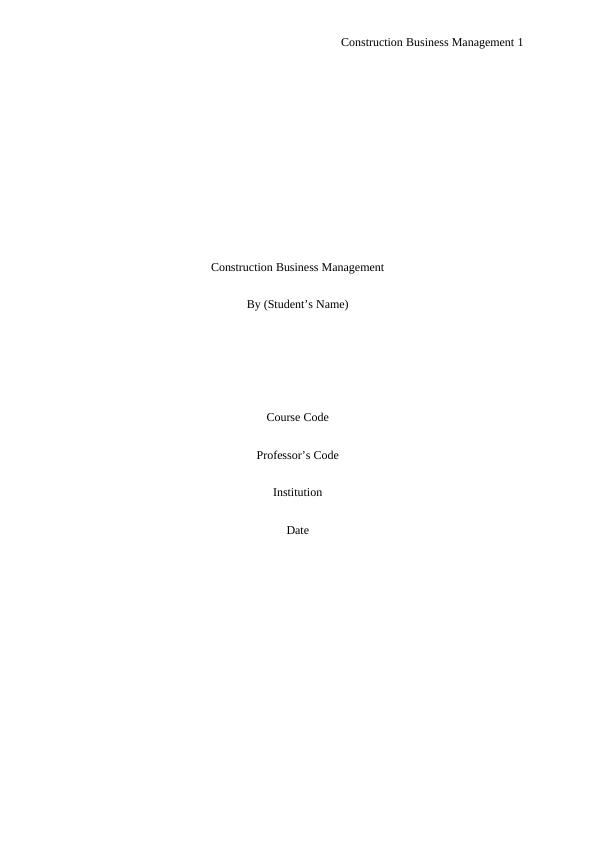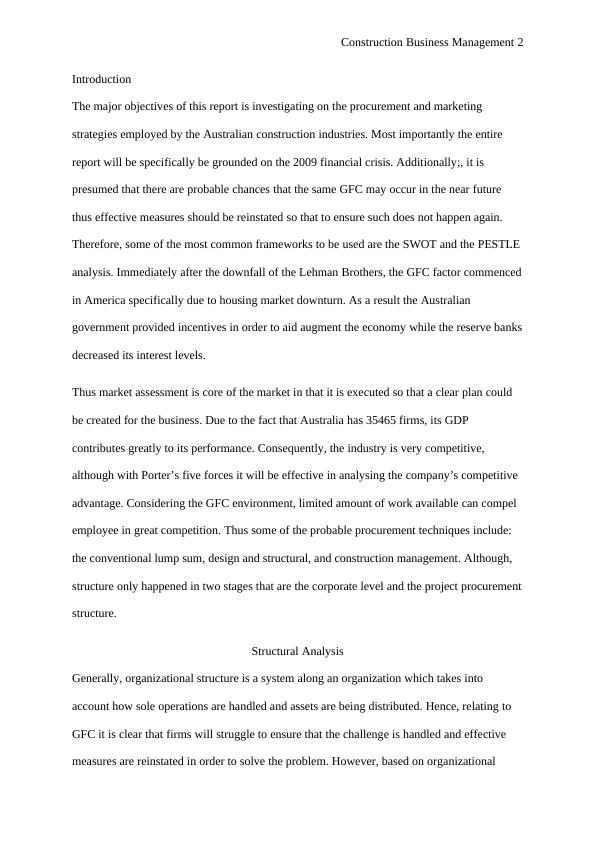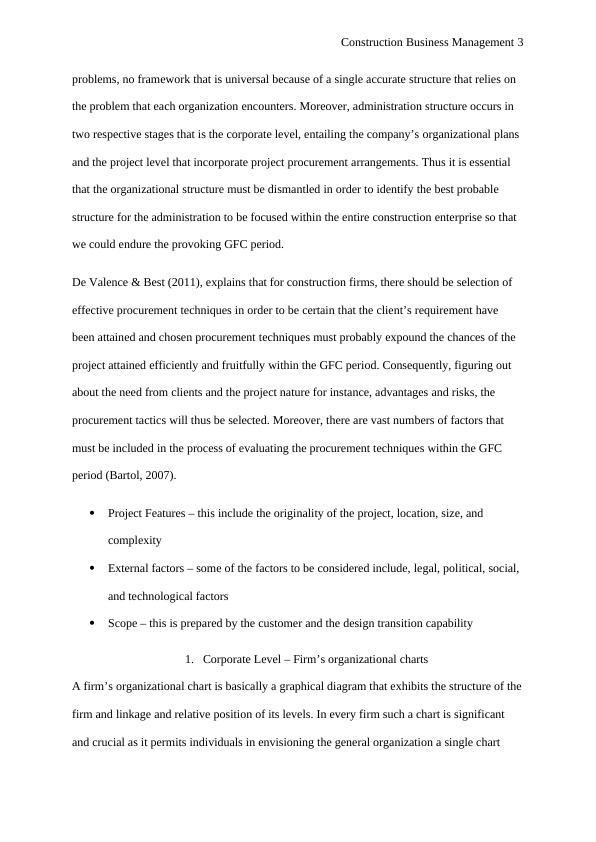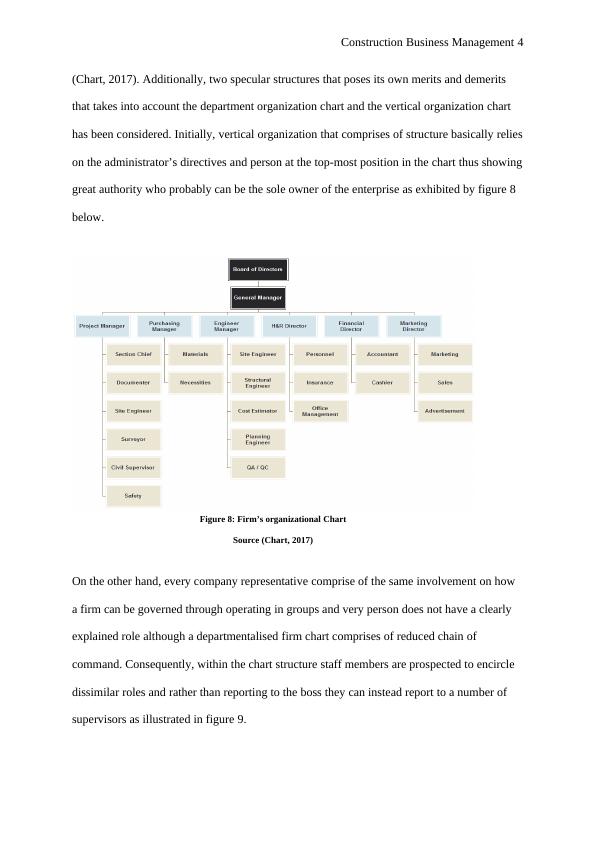Investigating Procurement and Marketing Strategies in Australian Construction Industries
Added on 2023-04-04
12 Pages2292 Words220 Views
Construction Business Management 1
Construction Business Management
By (Student’s Name)
Course Code
Professor’s Code
Institution
Date
Construction Business Management
By (Student’s Name)
Course Code
Professor’s Code
Institution
Date

Construction Business Management 2
Introduction
The major objectives of this report is investigating on the procurement and marketing
strategies employed by the Australian construction industries. Most importantly the entire
report will be specifically be grounded on the 2009 financial crisis. Additionally;, it is
presumed that there are probable chances that the same GFC may occur in the near future
thus effective measures should be reinstated so that to ensure such does not happen again.
Therefore, some of the most common frameworks to be used are the SWOT and the PESTLE
analysis. Immediately after the downfall of the Lehman Brothers, the GFC factor commenced
in America specifically due to housing market downturn. As a result the Australian
government provided incentives in order to aid augment the economy while the reserve banks
decreased its interest levels.
Thus market assessment is core of the market in that it is executed so that a clear plan could
be created for the business. Due to the fact that Australia has 35465 firms, its GDP
contributes greatly to its performance. Consequently, the industry is very competitive,
although with Porter’s five forces it will be effective in analysing the company’s competitive
advantage. Considering the GFC environment, limited amount of work available can compel
employee in great competition. Thus some of the probable procurement techniques include:
the conventional lump sum, design and structural, and construction management. Although,
structure only happened in two stages that are the corporate level and the project procurement
structure.
Structural Analysis
Generally, organizational structure is a system along an organization which takes into
account how sole operations are handled and assets are being distributed. Hence, relating to
GFC it is clear that firms will struggle to ensure that the challenge is handled and effective
measures are reinstated in order to solve the problem. However, based on organizational
Introduction
The major objectives of this report is investigating on the procurement and marketing
strategies employed by the Australian construction industries. Most importantly the entire
report will be specifically be grounded on the 2009 financial crisis. Additionally;, it is
presumed that there are probable chances that the same GFC may occur in the near future
thus effective measures should be reinstated so that to ensure such does not happen again.
Therefore, some of the most common frameworks to be used are the SWOT and the PESTLE
analysis. Immediately after the downfall of the Lehman Brothers, the GFC factor commenced
in America specifically due to housing market downturn. As a result the Australian
government provided incentives in order to aid augment the economy while the reserve banks
decreased its interest levels.
Thus market assessment is core of the market in that it is executed so that a clear plan could
be created for the business. Due to the fact that Australia has 35465 firms, its GDP
contributes greatly to its performance. Consequently, the industry is very competitive,
although with Porter’s five forces it will be effective in analysing the company’s competitive
advantage. Considering the GFC environment, limited amount of work available can compel
employee in great competition. Thus some of the probable procurement techniques include:
the conventional lump sum, design and structural, and construction management. Although,
structure only happened in two stages that are the corporate level and the project procurement
structure.
Structural Analysis
Generally, organizational structure is a system along an organization which takes into
account how sole operations are handled and assets are being distributed. Hence, relating to
GFC it is clear that firms will struggle to ensure that the challenge is handled and effective
measures are reinstated in order to solve the problem. However, based on organizational

Construction Business Management 3
problems, no framework that is universal because of a single accurate structure that relies on
the problem that each organization encounters. Moreover, administration structure occurs in
two respective stages that is the corporate level, entailing the company’s organizational plans
and the project level that incorporate project procurement arrangements. Thus it is essential
that the organizational structure must be dismantled in order to identify the best probable
structure for the administration to be focused within the entire construction enterprise so that
we could endure the provoking GFC period.
De Valence & Best (2011), explains that for construction firms, there should be selection of
effective procurement techniques in order to be certain that the client’s requirement have
been attained and chosen procurement techniques must probably expound the chances of the
project attained efficiently and fruitfully within the GFC period. Consequently, figuring out
about the need from clients and the project nature for instance, advantages and risks, the
procurement tactics will thus be selected. Moreover, there are vast numbers of factors that
must be included in the process of evaluating the procurement techniques within the GFC
period (Bartol, 2007).
Project Features – this include the originality of the project, location, size, and
complexity
External factors – some of the factors to be considered include, legal, political, social,
and technological factors
Scope – this is prepared by the customer and the design transition capability
1. Corporate Level – Firm’s organizational charts
A firm’s organizational chart is basically a graphical diagram that exhibits the structure of the
firm and linkage and relative position of its levels. In every firm such a chart is significant
and crucial as it permits individuals in envisioning the general organization a single chart
problems, no framework that is universal because of a single accurate structure that relies on
the problem that each organization encounters. Moreover, administration structure occurs in
two respective stages that is the corporate level, entailing the company’s organizational plans
and the project level that incorporate project procurement arrangements. Thus it is essential
that the organizational structure must be dismantled in order to identify the best probable
structure for the administration to be focused within the entire construction enterprise so that
we could endure the provoking GFC period.
De Valence & Best (2011), explains that for construction firms, there should be selection of
effective procurement techniques in order to be certain that the client’s requirement have
been attained and chosen procurement techniques must probably expound the chances of the
project attained efficiently and fruitfully within the GFC period. Consequently, figuring out
about the need from clients and the project nature for instance, advantages and risks, the
procurement tactics will thus be selected. Moreover, there are vast numbers of factors that
must be included in the process of evaluating the procurement techniques within the GFC
period (Bartol, 2007).
Project Features – this include the originality of the project, location, size, and
complexity
External factors – some of the factors to be considered include, legal, political, social,
and technological factors
Scope – this is prepared by the customer and the design transition capability
1. Corporate Level – Firm’s organizational charts
A firm’s organizational chart is basically a graphical diagram that exhibits the structure of the
firm and linkage and relative position of its levels. In every firm such a chart is significant
and crucial as it permits individuals in envisioning the general organization a single chart

Construction Business Management 4
(Chart, 2017). Additionally, two specular structures that poses its own merits and demerits
that takes into account the department organization chart and the vertical organization chart
has been considered. Initially, vertical organization that comprises of structure basically relies
on the administrator’s directives and person at the top-most position in the chart thus showing
great authority who probably can be the sole owner of the enterprise as exhibited by figure 8
below.
On the other hand, every company representative comprise of the same involvement on how
a firm can be governed through operating in groups and very person does not have a clearly
explained role although a departmentalised firm chart comprises of reduced chain of
command. Consequently, within the chart structure staff members are prospected to encircle
dissimilar roles and rather than reporting to the boss they can instead report to a number of
supervisors as illustrated in figure 9.
Figure 8: Firm’s organizational Chart
Source (Chart, 2017)
(Chart, 2017). Additionally, two specular structures that poses its own merits and demerits
that takes into account the department organization chart and the vertical organization chart
has been considered. Initially, vertical organization that comprises of structure basically relies
on the administrator’s directives and person at the top-most position in the chart thus showing
great authority who probably can be the sole owner of the enterprise as exhibited by figure 8
below.
On the other hand, every company representative comprise of the same involvement on how
a firm can be governed through operating in groups and very person does not have a clearly
explained role although a departmentalised firm chart comprises of reduced chain of
command. Consequently, within the chart structure staff members are prospected to encircle
dissimilar roles and rather than reporting to the boss they can instead report to a number of
supervisors as illustrated in figure 9.
Figure 8: Firm’s organizational Chart
Source (Chart, 2017)

End of preview
Want to access all the pages? Upload your documents or become a member.
Related Documents
Challenges and Solutions for Financial Accounting Management in BDO Globallg...
|9
|2486
|219
Strategic Transformation Program for SBlg...
|12
|4159
|48
Planning a Project for BDO Global: Challenges and Solutionslg...
|6
|1526
|303
Introduction to Contracts and Procurement | Reportlg...
|5
|856
|13
Project Management: Implementation, Management Plan, Control, and Closurelg...
|10
|2813
|95
MPM701 Assignment on the Business Process Managementlg...
|8
|566
|66
